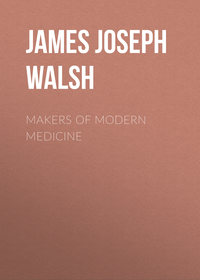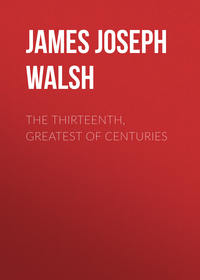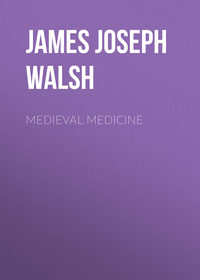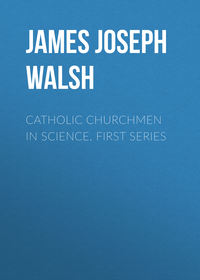 полная версия
полная версияThe Popes and Science
Outsiders dipping into the history of medicine have made much of our paucity of documentary evidence with regard to what Mondino actually did, and have, when it suited their purpose, insisted that this first author of a dissector's manual did but the three or four dissections explicitly mentioned. Those who are more familiar with the history of medicine, and especially of anatomy, are persuaded that he must have done many. In the first class of writers is Prof. White, for instance, who declares positively that Mondino did not dissect more bodies than those of which we have absolute records. According to his emphatically expressed opinion, the reason why the father of dissection did not dissect more was because of ecclesiastical opposition. Even these few dissections were due to some favoring chance or the laxity of the ecclesiastical authorities, or Mondino might have paid dear for his audacity. No one else, according to Prof. White, dared to encounter the awful penalties that might have been inflicted on Mondino until Vesalius, more than two centuries later, broke through "the ecclesiastical barrier" and gave liberty to anatomists. Prof. Lewis S. Pilcher, of Brooklyn, who has made a special study of Mondino and his times, who has consulted that author's original editions, who has searched out the traditions with regard to him in the very scene of his labors in Bologna, thinks quite differently. Prof. White has a purpose, that of minimizing the work done in anatomy during the fourteenth century; Prof. Pilcher's only purpose is to bring out the truth with regard to the history of anatomy. In the Medical Library and Historical Journal for December, 1906, Prof. Pilcher has an article entitled The Mondino Myth, by which term he designates the idea that Mondino dissected but a few bodies. He says with regard to this subject:
"The changes have been rung by medical historians upon a casual reference in Mondino's chapter on the uterus to the bodies of two women and one sow which he had dissected, as if these were the first and the only cadavers dissected by him. The context involved no such construction. He is enforcing a statement that the size of the uterus may vary, and to illustrate it remarks that, 'a woman whom I anatomized in the month of January last year (1315 Anno Christi), had a larger uterus than one whom I anatomized in the month of March of the same year.' And further, he says, 'the uterus of a sow which I dissected in 1316 (the year in which he was writing) was a hundred times greater than any I had seen in the human female, for she was pregnant, and contained thirteen pigs.' These happen to be the only references to specific bodies that he makes in his treatise. But it is a far cry to wring out of these references the conclusions that these are the only dissections he made. It is quite true that if we incline to enshroud his work in a cloud of mystery, and to figure it as an unprecedented, awe-inspiring feature to break down the prejudices of the ages, it is easy to think of him as having timidly profaned the human body in his anatomizing zeal in but one or two instances. His own language, however, throughout his book is that of a man who was familiar with the differing conditions of the organs found in many different bodies–a man who was habitually dissecting."
As I think must be clear to any one who knows Mondino's book, no other conclusion than this suggested by Prof. Pilcher can be drawn. This opinion has been frankly stated, by every historian of anatomy in recent years. Puschmann says it very clearly. Von Töply is evidently of the same opinion. These are the latest authorities in the history of anatomy. No other conclusion than this could well be reached by anyone who has studied the question seriously. Pilcher confirms this in the article already quoted in the following paragraph:
"Salernum was not alone in its legalization of the dissection of human bodies before the first public work of Mondino, for, according to a document of the Maggiore Consiglio of Venice of 1308, it appears that there was a college of medicine in Venice, which was even then authorized to dissect a body once every year. Common experience tells us that the embodiment of such regulations into formal law would occur only after a considerable preceding period of discussion, and in this particular field, of clandestine practice. It is too much to ask us to believe that in all this period, from the date of the promulgation of Frederick's decree of 1241 to the first public demonstration by Mondino at Bologna in 1315, the decree had been a dead letter and no human body had been anatomized. It is true there is not, as far as I am aware, any record of any such work, and commentators and historians of a later date have, without exception, accepted the view that none was done, and thereby heightened the halo assigned to Mondino as the one who ushered a new era. Such a view seems to me to be incredible. Be that as it may, it is undeniable that at the beginning of the fourteenth century the idea of dissecting the human body was not a novel one; the importance of a knowledge of the intimate structure of the body had already been appreciated by divers ruling bodies, and specific regulations prescribing its practice had been enacted. It is more reasonable to believe that in the era preceding immediately that of Mondino, human bodies were being opened and after a fashion anatomized. All that we know of the work of Mondino suggests that it was not a new enterprise in which he was a pioneer, but rather that he brought to an old practice a new enthusiasm and better methods, which, caught on the rising wave of interest in medical teaching at Bologna, and preserved by his own energy as a writer in the first original systematic treatise written since the time of Galen, created for him in subsequent uncritical times the reputation of being the restorer of the practice of anatomizing the human body, the first one to demonstrate and teach such knowledge since the time of the Ptolemaic anatomists, Erasistratus and Herophilus."
In order to show that Mondino did not perform only the two or three dissections which he himself for special reasons mentions, but many more, Professor Pilcher has made a series of quotations from the Bolognese anatomist's manual of dissection. It is after all quite easy to understand that if dissections were common, there would be no records of most of them, as they would be too commonplace for chroniclers to mention. Only those that have some special feature are by chance mentioned in some accounts of doings at the university. The records of the actual number of dissections at most medical schools, even a century ago, are not now available in most cases. On the other hand, no one can read these quotations from Mondino's book without realizing that the man who wrote these passages had made many dissections, and that it was a common practice for him to make anatomical preparations in many different ways, under many different circumstances and for many different purposes.
The second quotation shows, in fact, that Mondino had the custom sometimes of boiling his bodies before dissecting them when he wished to demonstrate special features, and he promises to make such an anatomy for his students at another time. If the bull of Pope Boniface VIII. was misinterpreted in any way to prohibit dissection, this would surely be the practice supposed to fall under its provisions. Here we find Mondino, less than twenty years after the promulgation of the bull, writing about this very practice, however, and calmly suggesting that he follows it as a routine, in a book that was published without let or hindrance from the ecclesiastical authorities, and that became for the next two centuries the most used book in the teaching of anatomy in educational institutions that were directly under ecclesiastical authorities. If the bull was misinterpreted so as to forbid dissection, as has been said, surely this flagrant violation of it would not have been permitted. It is clear that, if there was a misinterpretation, it must have come later in the history of anatomy. But of that we shall find no trace any more than at this time.
Here are the quotations from the Anatomy of Mondino which show that he practiced not one but many methods of making dissections, according to the purposes he had in view. The leaf and line references are to the Dryander Edition, Marburg, 1541. (Taken from Prof. Pilcher.)
"I do not consider separately here the anatomy of component parts, because their anatomy does not appear clearly in the fresh subject, but rather in those macerated in water." (Leaf 2, lines 8-13.)
".... these differences are more noticeable in the cooked or perfectly dried body, and so you need not be concerned about them, as perhaps I will make an anatomy upon such a one at another time and will write what I observe with my own senses, as I have proposed from the beginning." (Leaf 60, lines 14-17.)
"What the members are to which these nerves come cannot well be seen in such dissection as this, but it should be liquified with rain water, and this is not contemplated in the present body." (Leaf 60, lines 31-33.)
"After the veins you will note many muscles and many large and strong cords, the complete anatomy of which you will not endeavor to find in such a body, but in a body dried in the sun for three years, as I have demonstrated at another time; I also declared completely their number, and wrote the anatomy of the muscles of the arms, hands and feet in a lecture which I gave over the first, second, third and fourth subjects."
As must be clear to anyone, many of these expressions are, as Professor Pilcher insists, intelligible only if we accept the conclusion that their author had done many dissections, under many and varying circumstances, during his career as an anatomist before writing this volume. We have other evidence, of a much more direct character, for this fact. Mondino uses the expression, that he had demonstrated many times a certain anatomical feature which could only be the subject of demonstration after dissection. The expression occurs in a description of the hypo-gastric region which he calls the sumen. Through this region, he says, there pass to the surface certain veins which transmit fluid in the fetus during the time of its life in utero. For this reason they are better studied in the unborn than in the fully developed, since they lose their function as soon as complete development is reached. In this description Mondino uses the words "ego hoc modo multitotiens monstravi."
As with regard to this, so as to another bit of evidence of Mondino's frequency of dissection, Professor Pilcher has supplied the material. He says in his article on the Mondino Myth, already cited:
"Shortly after his (Mondino's) death, the young Guy de Chauliac, of Montpelier, came to Bologna to study anatomy under the tuition of Mondino's successor, Bertrucius. When he wrote his own treatise, 'La Grande Chirurgie,' thirty years later, he prefaced it with an appreciation of the study of anatomy, saying: 'It is necessary and useful to every physician to know first of all anatomy'; and that a knowledge of anatomy was to be acquired by two means; 'these are,' he says, 'the study of books, a means useful indeed, but not sufficient to explain those things which can only be appreciated by the senses; the other, experimentally on the dead body, according to the treatise of Mondinus, of Bologna, which he has written, and which (experimental anatomy on the cadaver) he (Mondinus) has done many times'–'et ipsam fecit multitoties.'"
Besides this evidence we have details of the lives of two of Mondino's assistants which furnish further proofs of the frequency of dissection at the University of Bologna during these first two decades of the fourteenth century, which, it will be recalled, are also the first two decades after the promulgation of Pope Boniface's bull. Curiously enough, one of these assistants was a young woman who, as was not infrequently the custom at this time in the Italian universities, was matriculated as a student at Bologna. She took up first philosophy and afterwards anatomy under Mondino. While it is not generally realized, co-education was quite common at the Italian universities of the thirteenth and fourteenth centuries, and at no time since the foundation of the universities has a century passed in Italy without distinguished women occupying professors' chairs at some of the Italian universities. This young woman, Alessandra Giliani, of Persiceto, a country district not far from Bologna, took up the study of anatomy with ardor and, strange as it may appear, became especially enthusiastic about dissection. She became so skilful that she was made the prosector of anatomy, that is, one who prepares bodies for demonstration by the professor.
According to the Cronaca Persicetana, quoted by Medici in his History of the Anatomical School of Bologna:
"She became most valuable to Mondino because she would cleanse most skilfully the smallest vein, the arteries, all ramifications of the vessels, without lacerating or dividing them, and to prepare them for demonstration she would fill them with various colored liquids, which, after having been driven into the vessels, would harden without destroying the vessels. Again, she would paint these same vessels to their minute branches so perfectly and color them so naturally that, added to the wonderful explanations and teachings of the master, they brought him great fame and credit." This whole passage shows a wonderful anticipation of all our most modern methods–injection, painting, hardening–of making anatomical preparations for class and demonstration purposes.
Some of the details of the story have been doubted, but her memorial tablet, erected at the time of her death in the Church of San Pietro e Marcellino of the Hospital of Santa Maria de Mareto, gives all the important facts, and tells also the story of the grief of her fiance, who was himself Mondino's other assistant. This was Otto Agenius, who had made for himself a name as an assistant to the chair of Anatomy in Bologna, and of whom there were great hopes entertained because he had already shown signs of genius as an investigator in anatomy. These hopes were destined to grievous disappointment, however, for Otto died suddenly, before he had reached his thirtieth year. The fact that both these assistants of Mondino died young and suddenly, would seem to point to the fact that probably dissection wounds in those early days proved even more fatal than they occasionally did a century or more ago, when the proper precautions against them were not so well understood. The death of Mondino's two prosectors in early years would seem to hint at some such unfortunate occurrence.
As regards the evidence of what the young man had accomplished before his untimely death, probably the following quotation, which Medici has taken from one of the old chroniclers, will give the best idea. He said:
"What advantage indeed might not Bologna have had from Otto Agenius Lustrolanus, whom Mondino had used as an assiduous prosector, if he had not been taken away by a swift and lamentable death before he had completed the sixth lustrum of his life!"
Further absolute proof that dissections were very common about the time that Mondino made those which are recorded, and the mention of which has led to the false assumption as to the rarity of dissection, is to be found in the legal prosecution for body-snatching, which I have already mentioned and which took place within five years after Mondino made the public demonstrations in dissection that are the subject of discussion. It will be conceded by everyone that such prosecutions for body-snatching are not likely to occur when only one or two graves are violated a year, but are usually the result of a series of such outrages, which arouse the community against them. We prefer to give this bit of history once more in the words of Professor Pilcher, who has argued this whole case for the frequency of dissection within twenty years after the bull that is supposed to have forbidden it better than anyone else, and whose knowledge of Mondino and his times is such as to make him an authority on the subject. He has no interest in them, as I have said, either for or against the Popes. His only idea is to bring out the real meaning of whatever data we possess for the history of anatomy and dissection at this time.
"An instructive and interesting side-light on the conditions attending the study of practical anatomy in the days of Mondino may be found in a record, still extant, of a legal procedure which occurred in Bologna in the year 1319, four years after Mondino had begun his public demonstrations and at a time when Otto and Alessandra were doubtless enthusiastically working with him. According to the record, four students, three from Milan and one from Piacenza, were accused of having gone at night time to the cemetery of the church of San Barnada, outside the San Felice gate, and to have sacrilegiously violated the grave in which was buried the body of a certain Pasino who had been hung on the gallows near the Ponte di Reno. It was charged that the students had taken up the body and carried it to the school of the parish of San Salvatore, near the pharmacy of Giacomo de Guido, where Master Alberto (Zancari) was teaching. There were witnesses who affirmed that they had seen the body of Pasino in the school and the students and others intent upon dissecting it. It was the sixth of December when the arrests were made, but the final outcome of the trial is not stated."
Surely all this must be considered sufficient evidence to show that Pope Boniface's bull neither forbade dissection, nor was misinterpreted as prohibiting any practice in connection with anatomical investigation. It is not enough for President White, however, for after the publication of my original article in the Medical Library and Historical Journal on The Popes and Anatomy, and another article on Pope John XXII. and the Supposed Bull against Chemistry, President White wrote thus in reply: "Dr. Walsh takes up the decretal of Boniface VIII., in 1300, and endeavors to show that, so far from forbidding dissection, it had quite a different tenor, and that at sundry universities in Italy and at the University at Montpelier, in France, dissection was permitted and most openly practiced. This seems to me very disingenuous. The decretal of Boniface was construed universally as prohibiting dissections for any purpose whatever."
For President White, then, the publication of the text of the bull is only an endeavor to show that, so far from forbidding dissection, it had quite a different tenor. This endeavor seems to him very disingenuous(!) It matters not what evidence there may be for dissection, or lack of evidence as to ecclesiastical opposition, the decretal of Boniface was construed universally as prohibiting any dissections for any purpose whatever. All history must yield before the reiteration of the assertion that the Popes did forbid dissection, and that there was no anatomy during the thirteenth, fourteenth and fifteenth centuries, except such as by chance, in some way or other, succeeded in evading the Church regulations. It simply must have been so. President White has said it. For anyone to deny it is to question his historical infallibility. Only those who are disingenuous will dare to do so.
It is true, he grants there were some permits to dissect given, but these were wrung from the unwilling hands of the ecclesiastical authorities, and are only proofs of their opposition, not at all of their toleration of dissection. There is no limit to which Professor White will not go in order to maintain his proposition that the Popes did forbid anatomy, and that there was no anatomical investigation during the thirteenth, fourteenth and fifteenth centuries. Here, for instance, is a paragraph from Professor White's answer which shows very strikingly one method of arguing with regard to a question of major significance in the history of education as well as of science, and especially of medicine, during the Middle Ages. Comments on it are entirely unnecessary:
"And now, as to Dr. Walsh's statement that dissection was permitted by Popes and ecclesiastical authorities in universities. His argument in the matter is an excellent example of Jesuitism. It is true that under the pressure of the developing science of medicine, sundry civil and ecclesiastical authorities did, from time to time, issue permits allowing an occasional dissection, at rare intervals, here and there; as, for example, the permission given to the University of Lerida, in 1391, to dissect one dead criminal every three years, and to sundry other universities to dissect one or two human bodies each year. It is a fact of which we have ample testimony, that Mundinus, the great anatomist preceding Vesalius, only dissected three human bodies with his classes during his entire career. So far from effectually helping anatomy, these permissions served really to fasten the idea upon the European mind that dissection to any considerable extent by anatomical investigators ought not to be allowed, and, as a matter of fact, it was not until Vesalius, in spite of theological opposition, braved calumny, persecution, and possibly death, that this ecclesiastical barrier to investigation was broken through." (Italics ours.)
Since Professor White has insisted so much on the significance of these permissions, a discussion of them will not be out of place. There are records of a certain small number of permissions to dissect having been granted by the Popes to various universities during the fourteenth and fifteenth centuries. These are so few, however, that it would seem that if they represented the only opportunities afforded for dissection, then the development of anatomy must have been much hampered.
With regard to this, it may be said that if the Popes gave permission for dissection, then this practice was not forbidden by them. Here is the proof of it out of the mouths of those who say the opposite. Why should a permission be necessary, however, will be asked?
At the present moment such formal permissions are required quite as much in all civilized countries as they were during the Middle Ages. In certain parts of the United States a bond has to be filed by applicants before permission to dissect will be given. Dissection is recognized generally as a practice that needs definite regulation. Without such regulation all sorts of abuses would creep in. During the Middle Ages popular feeling was all against dissection. It was difficult, in many places, for the university authorities to obtain permission for dissection from their immediate political rulers. As a consequence of this they reverted to the theory, very generally accepted at that time, that the university was independent of the political authorities of the place in which it was situated, in educational matters, and an appeal was made directly to the ecclesiastical authorities for permission to dissect, as coming under their jurisdiction in education. They had thus obtained many other educational privileges that would not have been allowed them by municipalities, and they were successful also in this. Anyone who knows the details of the struggle of the universities to maintain the rights of their students and faculties against the encroachments of municipal and state authorities, will appreciate how much this possibility of appeal to the Pope meant for the universities of that time.
The permission to dissect was only another, but a very striking example, of ecclesiastical authority granting privileges to universities beyond those which they could have obtained from the local governments under which they existed. Such permissions, far from showing that the Popes were hampering or prohibiting dissection, prove, on the contrary, that they were securing for educational institutions what local popular prejudice would not have allowed them. That this is the proper way to view this question will be best appreciated by a review of the history of anatomy during the two centuries and a half in which ecclesiastical authorities are said to have prevented or discouraged its development. From this it will be seen very clearly that the nearer to Rome the medical schools were, the more dissection was done in them; that dissection was most common in Rome, at least during the latter part of this period; that the golden age of anatomy developed most luxuriantly in Bologna when that was a Papal city, and in Rome itself; and that in general the Popes must be looked upon as having fostered and patronized the medical sciences and anatomy in every possible way, while there is not the slightest hint anywhere to be found of the ecclesiastical opposition that is supposed to have dominated these centuries of medical history.











